Trend Analysis of Long-Term Reference Evapotranspiration and Its Components over the Korean Peninsula
Abstract
:1. Introduction
2. Methods
2.1. Estimation of
2.2. Estimation of Solar Radiation
2.3. Trend-Analysis Method
2.3.1. Parametric T-Test
2.3.2. Nonparametric Mann–Kendall test
2.4. Impact of Serial Correlation in a Time Series
3. Study Area and Data
4. Results and Discussion.
4.1. Regional Calibration of and Estimation of Solar Radiation
4.2. Estimation of Using the Penman–Monteith Method
4.3. Spatial Distribution of Mean Annual and Seasonal , , and
4.4. Differences in the Mean Annual and Seasonal , , and between SK and NK
4.5. Spatial Variation of Annual and Seasonal , , and Trends
4.6. Difference in Trends of Mean Annual and Seasonal , , and in SK and NK
5. Conclusions
- The spatial distribution of the mean annual exhibited increasing spatial variation in annual from NK to SK. A lower was evident for the northeastern Korean Peninsula, and higher values were found over the southeastern Korean Peninsula.
- The spatial distribution of the and revealed a clear distribution from the minimum in NK and reached the peak in SK for both energy and aerodynamic terms. The energy term is influenced by and T, and the aerodynamic term is affected by RH and WS. The lower latitude in NK causes a lower amount of than that in SK, and mean annual T in NK is lower than in SK because T in the northern area of the Korean Peninsula is mostly affected by the influx of cold air from the Siberian high. These superimposed effects cause the higher energy term in SK.
- A comparison of the mean annual showed that the average annual in SK was 18% higher than that in NK from 1980 to 2017. Additionally, the mean areal and is higher, at 9.3% and 49.7%, respectively, in SK than in NK.
- The results of the trends test indicate that the significant increasing trend of is mainly caused by significant increasing trends in the term in SK and NK. This finding indicates that is the dominant component affecting the over the Korean Peninsula. In addition, opposite trends exist for and on the Korean Peninsula (significant increasing trends for and significant decreasing trends for on seasonal and annual time scales). The different trends in the mentioned parameter mainly arise from the effect of meteorological variables on the energy and aerodynamic terms ( and T for and WS and RH for ).
Supplementary Materials
Author Contributions
Acknowledgments
Conflicts of Interest
References
- Gocic, M.; Trajkovic, S. Analysis of trends in reference evapotranspiration data in a humid agricultural water management climate. Hydrol. Sci. J. 2014, 59, 165–180. [Google Scholar] [CrossRef]
- Song, Z.; Zhang, H.; Snyder, R.; Anderson, F.; Chen, F. Distribution and trends in reference evapotranspiration in the North China Plain. J. Irrig. Drain. Eng. 2010, 136, 240–247. [Google Scholar] [CrossRef]
- Ren, J.; Li, Q.; Yu, M.; Li, H. Variation trends of meteorological variables and their impacts on potential evapotranspiration in Hailar region. Water Sci. Eng. 2012, 5, 137–144. [Google Scholar] [CrossRef]
- Fennessey, N.M.; Kirshen, P.H. Evaporation and evapotranspiration under climate change in New England. J. Water Resour. Plann. Manag. 1994, 120, 48–69. [Google Scholar] [CrossRef]
- Fisher, D.; Pringle III, H. Evaluation of alternative methods for estimating reference evapotranspiration. Agric. Sci. 2013, 4, 51–60. [Google Scholar] [CrossRef]
- Allen, R.G.; Pereira, L.S.; Raes, D.; Smith, M. Crop Evapotranspiration- Guidelines for Computing Crop Water Requirements- FAO Irrigation and Drainage Paper 56; Food and Agriculture Organization of the United Nations: Rome, Italy, 1998. [Google Scholar]
- Wang, K.; Dickinson, R.E. A review of global terrestrial evapotranspiration: Observation, modeling, climatology, and climatic variability. Rev. Geophys. 2012, 50, 1–54. [Google Scholar] [CrossRef]
- McVicar, T.R.; Roderick, M.L.; Donohue, R.J.; Li, T.; Van Niel, T.G.; Thomas, A.; Grieser, J.; Jhajharia, G.; Himri, H.; Mahowald, N.M.; et al. Global review and synthesis of trends in observed terrestrial near-surface wind speeds: implication for evaporation. J. Hydrol. 2012, 416, 182–205. [Google Scholar] [CrossRef]
- Zhang, Y.; Peña-Arancibia, J.L.; McVicar, T.R.; Chiew, F.H.S.; Vaze, J.; Liu, C.; Lu, X.; Zheng, H.; Wang, Y.; Liu, Y.; et al. Multi-decadal trends in global terrestrial evapotranspiration and its components. Nature: Sci. Rep. 2016, 6. [Google Scholar] [CrossRef] [PubMed] [Green Version]
- Wang, X.; Liu, H.; Zhang, L.; Zhang, R. Climate change trend and its effects on reference evapotranspiration at Linhe Station, Hetao Irrigation District. Water Sci. Eng. 2014, 7, 250–266. [Google Scholar] [CrossRef]
- Tabari, H.; Nikbakht, J.; Talaee, P.H. Identification of trend in reference evapotranspiration series with serial dependence in Iran. Water Resour. Manag. 2012, 26, 2219–2232. [Google Scholar] [CrossRef]
- Da Silva, V.D.P.R. On climate variability in northeast of Brazil. J. Arid Environ. 2004, 58, 575–596. [Google Scholar] [CrossRef]
- Yang, Z.; Zhang, Q.; Hao, X. Evapotranspiration trend and its relationship with precipitation over the loess plateau during the last three decades. Adv. Meteorol. 2016, 1–10. [Google Scholar] [CrossRef]
- Asanuma, J.; Kamimera, H. Long-term trends of the pan evaporation as an index of the global hydrological change. Proceeding of the International Symposium on Disaster Mitigation and Basin-Wide Water Management. UNESCO; 2003. [Google Scholar]
- Roderick, M.L.; Farquhar, G.D. Changes in New Zealand pan evaporation since the 1970s. Int. J. Climatol. 2005, 25, 2031–2039. [Google Scholar] [CrossRef] [Green Version]
- Tebakari, T.; Yoshitani, J.; Suvanpimol, C. Time-Space Trend Analysis in Pan Evaporation over Kingdom of Thailand. J. Hydrol. Eng. 2005, 10, 205–21. [Google Scholar] [CrossRef]
- Feng, G.; Cobb, S.; Abdo, Z.; Fisher, D.K.; Ouyang, Y.; Adeli, A.; Jenkins, J.N. Trend analysis and forecast of precipitation, reference evapotranspiration, and rainfall deficit in the blackland prairie of Eastern Mississippi. J. Appl. Meteorol. Climatol. 2016, 55, 1425–1439. [Google Scholar] [CrossRef]
- Gao, G.; Chen, D.; Xu, C.; Simelton, E. Trend of estimated actual evapotranspiration over China during 1960–2002. J. Geophys. Res.: Atmospheres 2007, 112, 1–8. [Google Scholar] [CrossRef]
- Li, M.; Chu, R.; Shen, S.; Islam, A.R.M.T. quantifying climatic impact on reference evapotranspiration trends in the huai river basin of Eastern China. Water 2018, 10, 144. [Google Scholar] [CrossRef]
- Mosaedi, A.; Ghabaei Sough, M.; Sadeghi, S.H.; Mooshakhian, Y.; Bannayan, M. Sensitivity analysis of monthly reference crop evapotranspiration trends in Iran: A qualitative approach. Theor. Appl. Climatol. 2016, 128, 1–17. [Google Scholar] [CrossRef]
- Hargreaves, G.H.; Samani, Z. Estimating potential evapotranspiration. J. Irrig. Drain. Div. 1982, 108, 225–230. [Google Scholar]
- Hargreaves, G.H. Simplified coefficients for estimating monthly solar radiation in North America and Europe; Department paper, Utah State University: Logan, Utah, UT, USA, 1994. [Google Scholar]
- Vanderlinden, K.; Giráldez, J.; Van Meirvenne, M. Assessing reference evapotranspiration by the hargreaves method in Southern Spain. J. Irrig. Drain. Eng. 2004, 130, 184–191. [Google Scholar] [CrossRef]
- Lee, K. Relative comparison of the local recalibration of the temperature-based evapotranspiration equation for the Korea Peninsula. J. Irrig. Drain. Eng. 2010, 136, 585–594. [Google Scholar] [CrossRef]
- Thepadia, M.; Martinez, C. Regional calibration of solar radiation and reference evapotranspiration estimates with minimal data in Florida. J. Irrig. Drain. Eng. 2012, 138, 111–119. [Google Scholar] [CrossRef]
- Xu, C.Y.; Gong, L.; Jiang, T.; Chen, D.; Singh, V.P. Analysis of spatial distribution and temporal trend of reference evapotranspiration and pan evaporation in Changjiang (Yangtze River) catchment. J. Hydrol. 2006, 327, 81–93. [Google Scholar] [CrossRef]
- Hirsch, R.M.; Slack, J.R.; Smith, R.A. Techniques of trend analysis for monthly water quality. Water Resour. Res. 1982, 18, 107–121. [Google Scholar] [CrossRef]
- Belle, G.V.; Hughes, J.P. Nonparametric tests for trend in water quality. Water Resour. Res. 1984, 20, 127–136. [Google Scholar] [CrossRef]
- Burn, D.H.; Elnur, M.A.H. Detection of hydrologic trends and variability. J. Hydrol. 2002, 255, 107–122. [Google Scholar] [CrossRef]
- Bayazit, M.; Önöz, B. To prewhiten or not to prewhiten in trend analysis? Hydrol. Sci. J. 2007, 52, 611–624. [Google Scholar] [CrossRef] [Green Version]
- Tabari, H.; Somee, B.S.; Zadeh, M.R. Testing for long-term trends in climatic variables in Iran. Atmos. Res. 2011, 100, 132–140. [Google Scholar] [CrossRef]
- Von Storch, H.; Navarra, A. Analysis of Climate Variability-Applications of Statistical Techniques.; Springer Verlag Publishing: Heidelberg, Germany, 1999. [Google Scholar]
- Partal, T.; Kahya, E. Trend analysis in Turkish precipitation data. Hydrol. Process. 2006, 20, 2011–2026. [Google Scholar] [CrossRef]
- Bae, D.H.; Jung, I.W.; Chang, H. Long-term trend of precipitation and runoff in Korean river basins. Hydrol. Processes 2008, 22, 2644–2656. [Google Scholar] [CrossRef]
- Xia, Y.; Fabian, P.; Stohl, A.; Winterhalter, M. Forest climatology: estimation of missing values for Bavaria, Germany. Agric. For. Meteorol. 1999, 96, 131–144. [Google Scholar] [CrossRef] [Green Version]
- Allen, R.G. Assessing integrity of weather data for reference evapotranspiration estimation. J. Irrig. Drain. Eng. 1996, 122, 97–106. [Google Scholar] [CrossRef]
- Daly, C. Guidelines for assessing the suitability of spatial climate data sets. Int. J. Climatol. J. R. Meteorolog. Soc. 2006, 26, 707–721. [Google Scholar] [CrossRef] [Green Version]
- Kim, Y.; Kang, B.; Adams, J.M. Opposite trends in summer precipitation in South and North Korea. Int. J. Climatol. 2012, 32, 2311–2319. [Google Scholar] [CrossRef]
- Huth, R.; Pokorna, L. Parametric versus non-parametric estimates of climatic trends. Theor. Appl. Climatol. 2004, 77, 107–112. [Google Scholar] [CrossRef]
- Tabari, H.; Talaee, P.H. Temporal variability of precipitation over Iran: 1966–2005. J. Hydrol. 2011, 396, 313–320. [Google Scholar] [CrossRef]

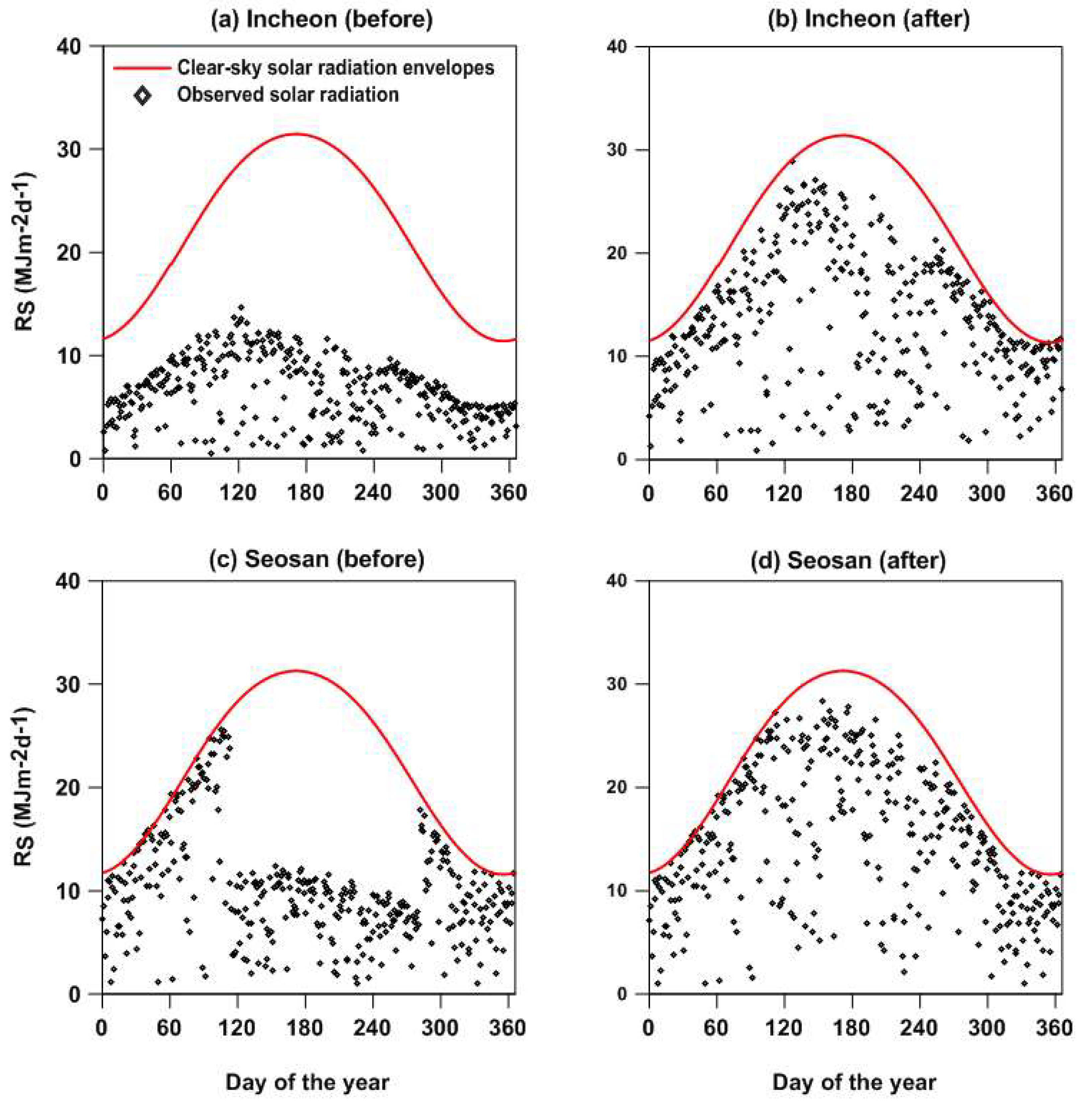
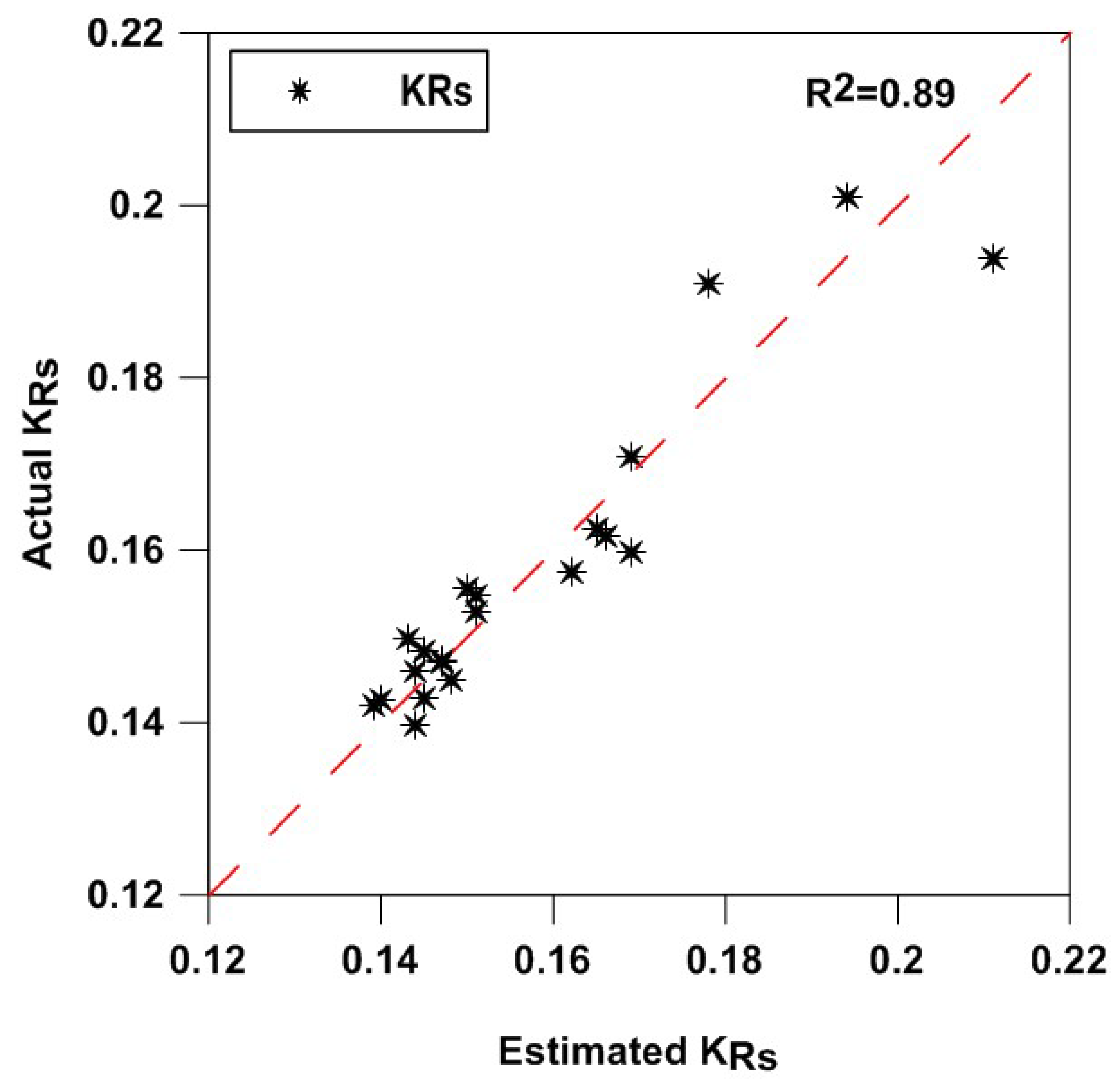


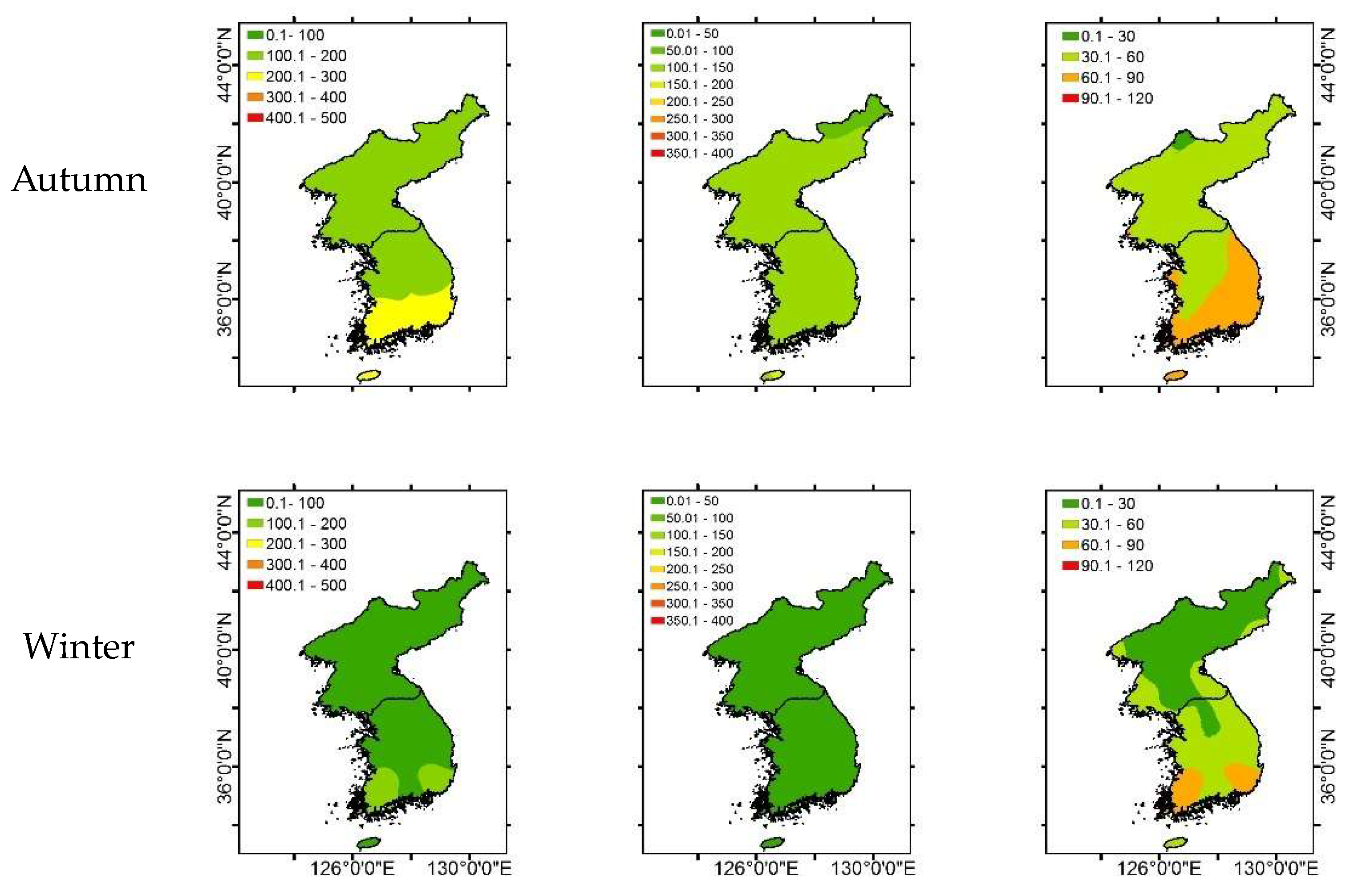
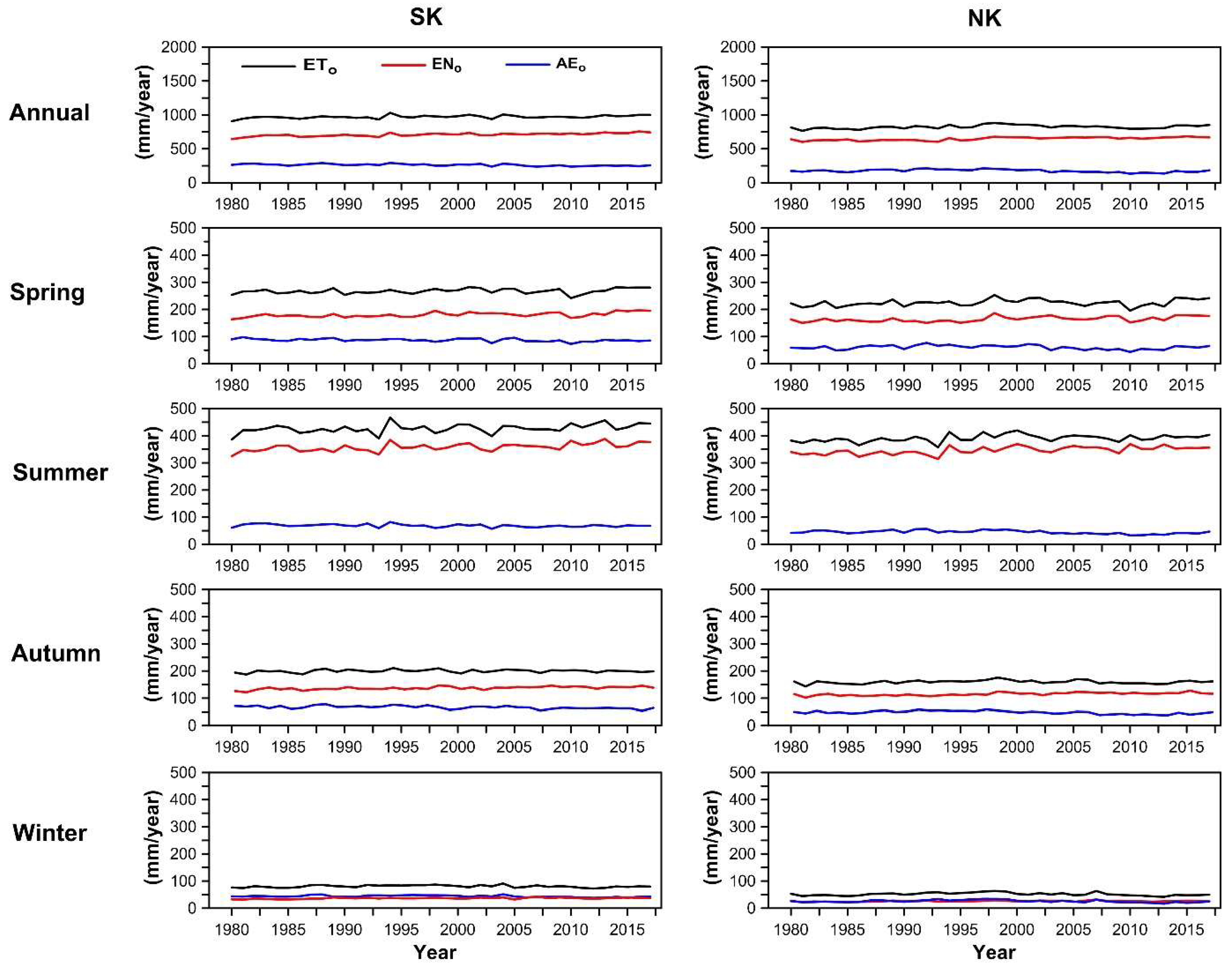

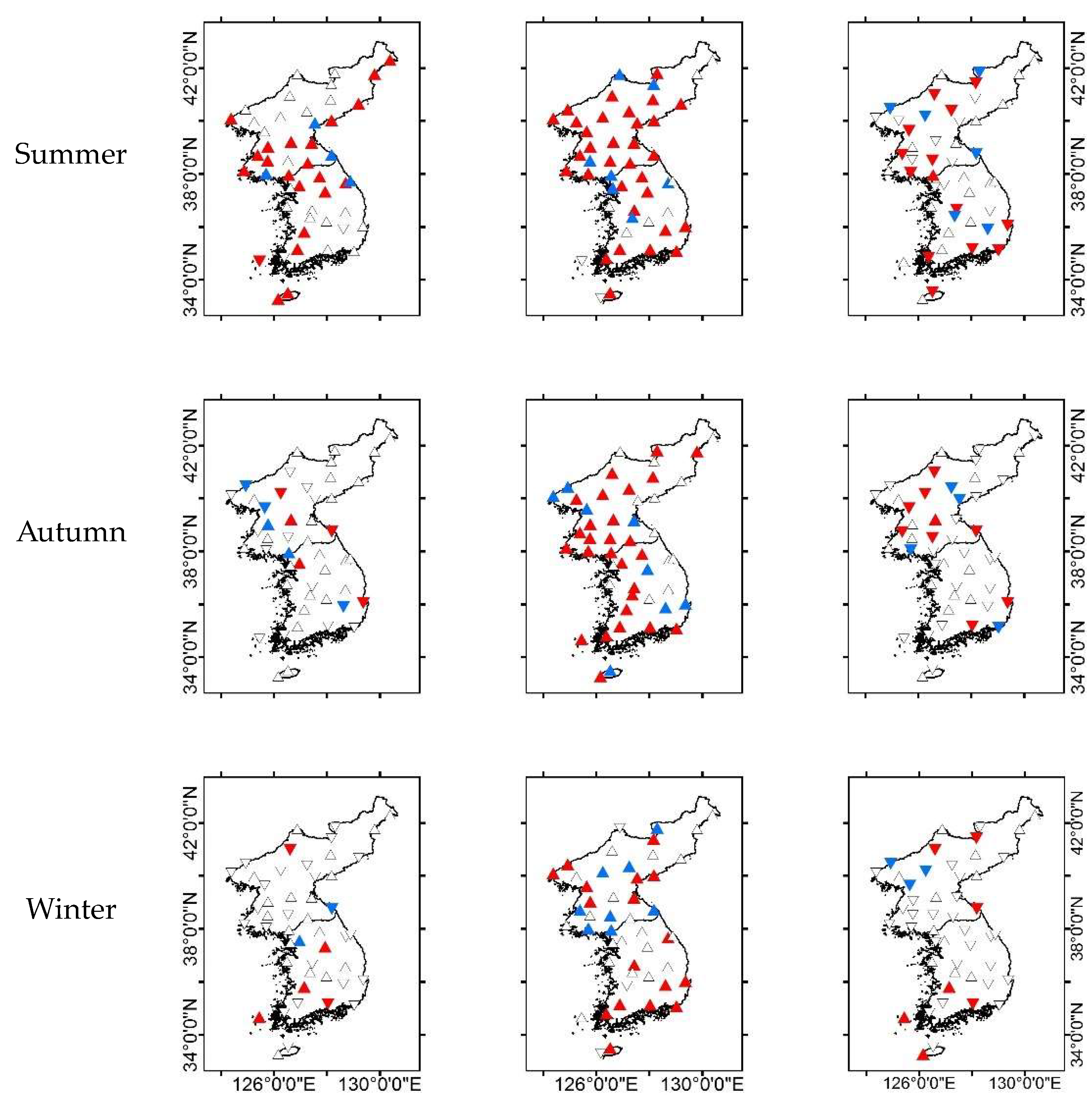
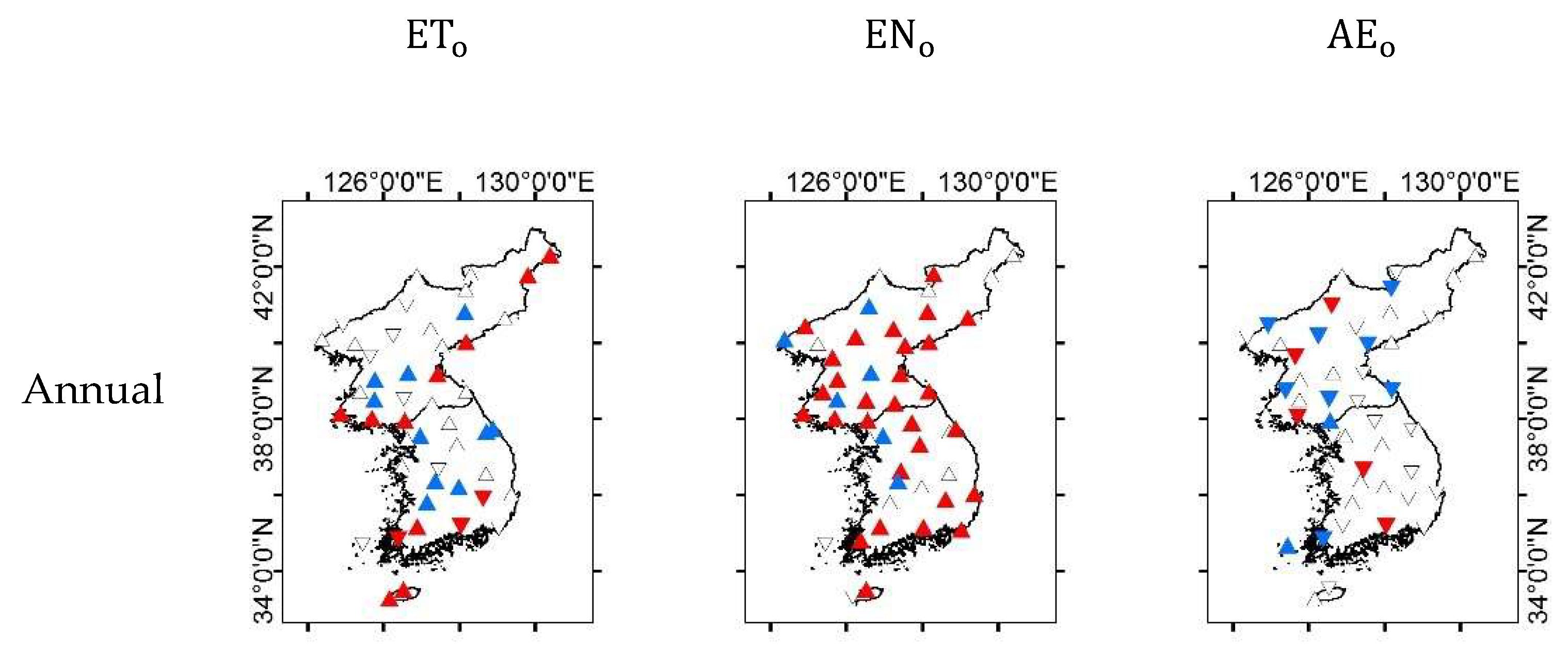
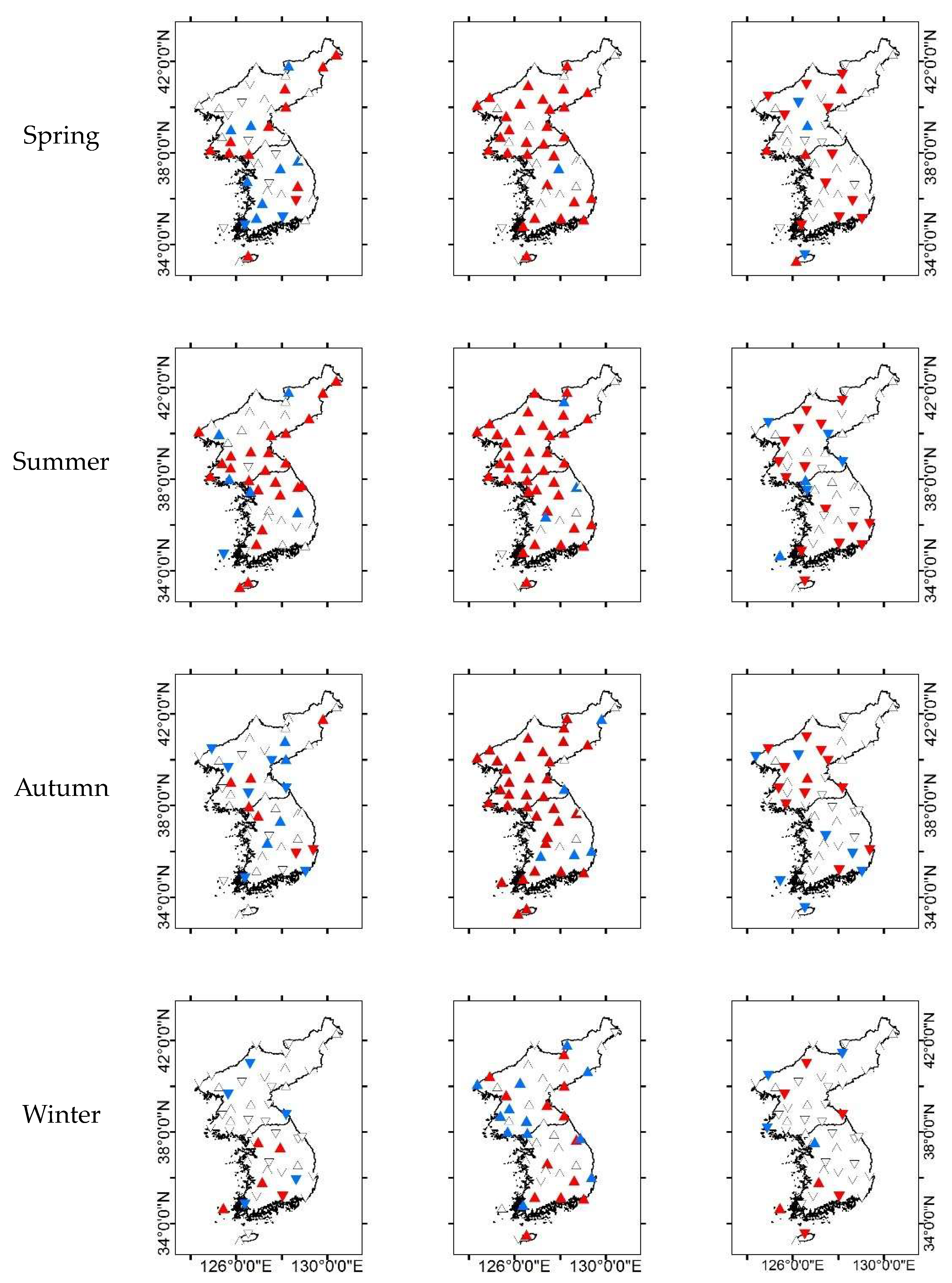
| Station Code | Station Name | R2 | Root-Mean-Square Error (RMSE) |
|---|---|---|---|
| 100 | Daegwalryeong | 0.87 | 3.00 |
| 101 | Chuncheon | 0.85 | 3.07 |
| 105 | Gangnung | 0.86 | 3.10 |
| 108 | Seoul | 0.84 | 3.57 |
| 112 | Incheon | 0.82 | 3.73 |
| 114 | Wonju | 0.66 | 4.96 |
| 129 | Seosan | 0.85 | 4.11 |
| 131 | Cheongju | 0.83 | 3.49 |
| 133 | Daejeon | 0.86 | 2.68 |
| 135 | Chupungyong | 0.81 | 3.53 |
| 136 | Andong | 0.84 | 2.98 |
| 138 | Pohang | 0.85 | 3.18 |
| 143 | Daegu | 0.89 | 2.71 |
| 146 | Jeonju | 0.88 | 2.81 |
| 156 | Gwangju | 0.88 | 2.70 |
| 159 | Busan | 0.86 | 3.17 |
| 165 | Mokpo | 0.89 | 2.59 |
| 184 | Jeju | 0.92 | 2.67 |
| 185 | Gosan | 0.87 | 2.84 |
| 169 | Heuksando | 0.90 | 1.78 |
| 192 | Jinju | 0.88 | 2.56 |
| Period | ETo | Annual ETo | ENo | AEo | ENo/ETo | AEo/ETo |
|---|---|---|---|---|---|---|
| (mm/year) | (%) | (mm/year) | (mm/year) | (%) | (%) | |
| South Korea | ||||||
| Spring | 267.6 | 27.6 | 180.5 | 87.1 | 67.4 | 32.6 |
| Summer | 426.9 | 44.0 | 358.0 | 68.9 | 83.9 | 16.1 |
| Autumn | 196.0 | 20.2 | 133.3 | 62.8 | 68.0 | 32.0 |
| Winter | 80.6 | 8.3 | 36.6 | 43.9 | 45.5 | 54.5 |
| Annual | 971.2 | 100.0 | 708.4 | 262.7 | 72.9 | 27.1 |
| North Korea | ||||||
| Spring | 224.9 | 27.3 | 164.4 | 60.5 | 73.1 | 26.9 |
| Summer | 391.1 | 47.5 | 346.3 | 44.8 | 88.6 | 11.4 |
| Autumn | 155.9 | 18.9 | 111.4 | 44.4 | 71.5 | 28.5 |
| Winter | 51.7 | 6.3 | 25.9 | 25.8 | 50.1 | 49.9 |
| Annual | 823.5 | 100.0 | 648.0 | 175.5 | 78.7 | 21.3 |
| Period | South Korea | North Korea | ||||||
|---|---|---|---|---|---|---|---|---|
| Parametric T-Test | Nonparametric MK Test | Parametric T-Test | Nonparametric MK Test | |||||
| T | B | Z | β | T | B | Z | β | |
| ETo | ||||||||
| Spring | 0.26 | 2.03 | 0.28 | 0.31 | 0.35 | |||
| Summer | 2.18 | 0.34 | 2.26 | 0.45 | 2.51 | 0.39 | 0.40 | |
| Autumn | 0.59 | 0.09 | 0.04 | –0.03 | 0.66 | 0.10 | 0.16 | –0.03 |
| Winter | –0.53 | –0.08 | –0.46 | –0.06 | –0.32 | –0.05 | –0.21 | –0.07 |
| Annual | 2.42 | 0.38 | 2.69 | 0.60 | 1.30 | 0.21 | 0.98 | 0.08 |
| ENo | ||||||||
| Spring | 2.23 | 0.35 | 0.23 | 2.42 | 0.38 | 0.33 | ||
| Summer | 3.47 | 0.55 | 0.65 | 2.90 | 0.46 | 0.54 | ||
| Autumn | 2.44 | 0.38 | 0.15 | 2.54 | 0.40 | 0.16 | ||
| Winter | 1.97 | 0.31 | 0.07 | 0.26 | 0.05 | |||
| Annual | 2.63 | 0.42 | 0.64 | 2.15 | 0.34 | 0.43 | ||
| AEo | ||||||||
| Spring | –2.73 | –0.43 | –2.34 | –0.18 | –0.82 | –0.14 | –0.64 | –0.17 |
| Summer | –2.61 | –0.41 | –2.54 | –0.22 | –1.60 | –0.27 | –1.62 | –0.18 |
| Autumn | –2.19 | –0.35 | –2.07 | –0.21 | –1.26 | –0.21 | –1.31 | –0.16 |
| Winter | –1.56 | –0.25 | –1.54 | –0.10 | –0.70 | –0.12 | –0.90 | –0.09 |
| Annual | –2.55 | –0.40 | –2.46 | –0.52 | –1.01 | –0.17 | –1.30 | –0.49 |
© 2018 by the authors. Licensee MDPI, Basel, Switzerland. This article is an open access article distributed under the terms and conditions of the Creative Commons Attribution (CC BY) license (http://creativecommons.org/licenses/by/4.0/).
Share and Cite
Ghafouri-Azar, M.; Bae, D.-H.; Kang, S.-U. Trend Analysis of Long-Term Reference Evapotranspiration and Its Components over the Korean Peninsula. Water 2018, 10, 1373. https://doi.org/10.3390/w10101373
Ghafouri-Azar M, Bae D-H, Kang S-U. Trend Analysis of Long-Term Reference Evapotranspiration and Its Components over the Korean Peninsula. Water. 2018; 10(10):1373. https://doi.org/10.3390/w10101373
Chicago/Turabian StyleGhafouri-Azar, Mona, Deg-Hyo Bae, and Shin-Uk Kang. 2018. "Trend Analysis of Long-Term Reference Evapotranspiration and Its Components over the Korean Peninsula" Water 10, no. 10: 1373. https://doi.org/10.3390/w10101373
APA StyleGhafouri-Azar, M., Bae, D.-H., & Kang, S.-U. (2018). Trend Analysis of Long-Term Reference Evapotranspiration and Its Components over the Korean Peninsula. Water, 10(10), 1373. https://doi.org/10.3390/w10101373





